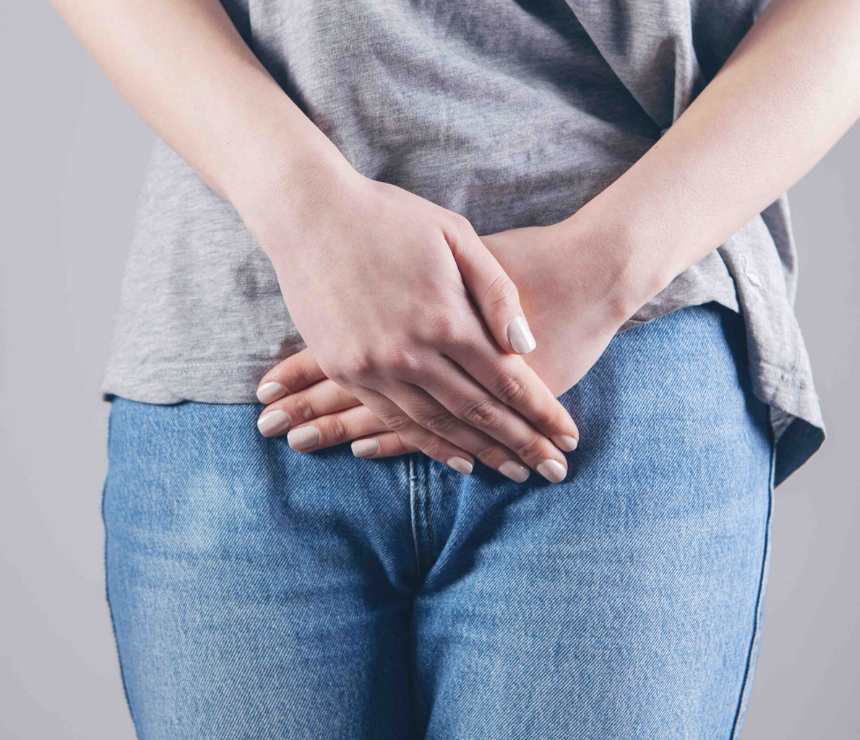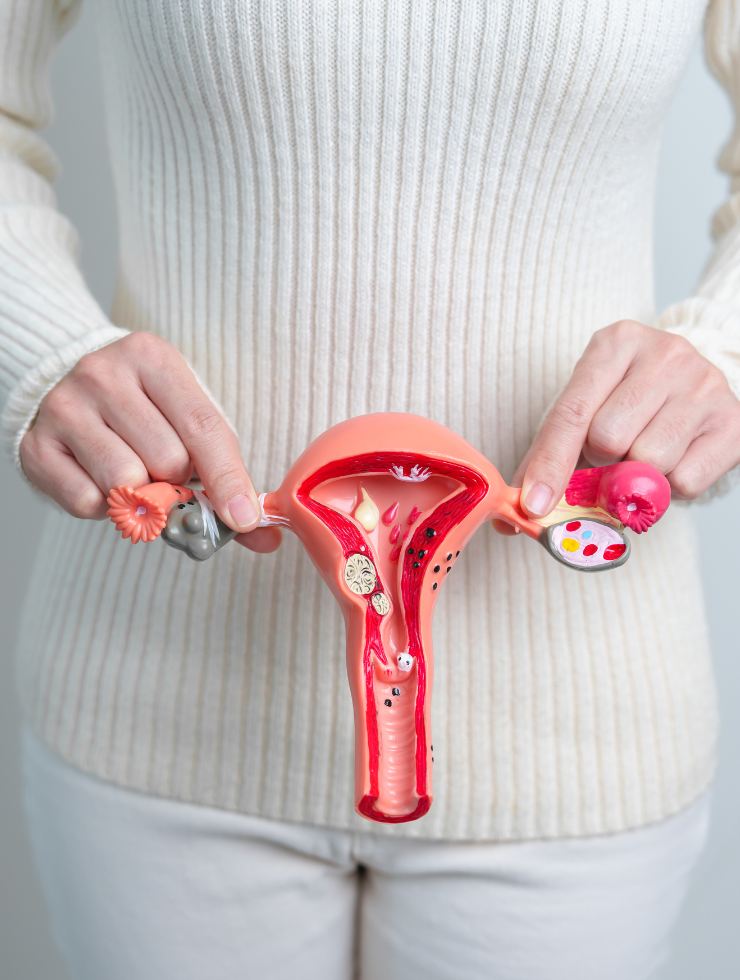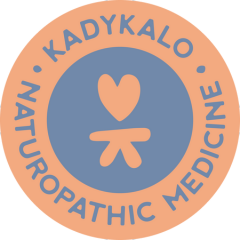Dr. Christine Kadykalo, ND • June 15, 2022
Endometriosis
What is Endometriosis?
It is a gynecological condition where there is uterine lining tissue growing outside of the uterine cavity, typically somewhere in the abdominal cavity.

Endometriosis is the most common cause of chronic pelvic pain in women.
BACKGROUND:
Symptoms include pelvic pain that can range from minor to severe, infertility, painful intercourse, and difficulty defecating. Endometriosis is the most common cause of chronic pelvic pain in women. (5)
Endometriosis is a very challenging condition to diagnose because the gold standard for diagnosis is laparoscopy which is an invasive procedure for diagnosis and so it is not often performed. Ultrasound and MRI imaging can identify cysts and endometrial growths but cannot definitively diagnose endometriosis. (9)
Conventional medicine treatments usually involve the use of a painkiller, such as Advil or Tylenol and surgical removal of the lesions. Surgery provides only modest effects and the unfortunate thing is that lesions often come back after surgery so this is not a curative treatment. (6) Suppression of estrogen production via contraceptive methods of oral birth control or an IUD, can be effective at reducing pain.
contributors of inflammation include exposure to environmental toxins (pesticides, plastics, smoke), poor nutrition, processed foods, inadequate sleep, inactivity and stress.
CAUSES:
There is no single determined cause of endometriosis and it is not yet fully understood. However, there are multiple components involved in the development and worsening of endometriosis.
Systems involved:
• Hormones
• Genetics
• Inflammation
• Digestive health
• Environmental exposures and ability to detox
• Stress

The hormone most often associated with endometriosis is estrogen.
The hormone component:
The hormone most often associated with endometriosis is estrogen. There is an increase in production of growth promoting form of estrogen and a loss of the protective form of estrogen. (7) There is also often excess exposure to exogenous estrogens (estrogen from the environment) with the inability to clear and metabolize estrogen properly via the liver and intestines. Therefore, treatment would require balancing hormones, ensuring the proper metabolism and detoxification of excess hormones via gut health and reducing exposure to environmental hormones (xenoestrogens).
However, it's not just about hormones!
Endometriosis is a chronic, inflammatory condition.
The expression of TNF-alpha (an inflammatory cytokine) is increased in the endometrial tissue of patients with endometriosis. Other inflammatory cells have also been studied and shown to be increased in endometriosis. (8)
Among other mechanisms, the inflammation is also associated with hormones estrogen and cortisol, indicating the link and importance of hormone balance and stress reduction. (8)
Other contributors of inflammation include exposure to environmental toxins (pesticides, plastics, smoke), poor nutrition, processed foods, inadequate sleep, inactivity and stress.
There is a lower risk of endometriosis with the consumption of fruits, vegetables and omega-3 fatty acids.
NATUROPATHIC TREATMENTS:
Nutrition matters!
There are certain dietary components that can make a big difference in reducing inflammation involved in endometriosis.
A gluten free diet has been associated with a 75% reduction in pain. (1)
There is an increased risk of endometriosis with higher consumption of trans fats and red meat (2). Women who consumed >2 servings of red meat a day had a 56% increased risk of developing endometriosis, compared to those who consumed <1 serving per week. (3)
There is a lower risk of endometriosis with the consumption of fruits, vegetables and omega-3 fatty acids. (2)
Specific nutrients:
Vitamin D supplementation has been shown to significantly reduce pelvic pain when compared with placebo. It also reduced the inflammatory marker, hs-CRP, and increased antioxidant capacity. (4) This particular study used 50,000 IU of Vitamin D every 2 weeks. It is best to have your Vitamin D level tested with your provider to determine the best dose for you.
Probiotics help to limit the amount of estrogen reabsorbed in the large intestine.
Fish oil helps to reduce inflammation.
A review article found that many nutrients provide benefit in endometriosis. Besides those already mentioned, the found positive effects with: zinc, Vitamin E, magnesium, Resveratrol, ECGC, ALA, NAC and Vitamin C. (11)
Herbs:
Curcumin reduces angiogenisis (the growth of new blood vessels to the ectopic endometrial tissue) and decreases inflammation. Be sure to use a good quality curcumin to see benefit.
Boswellia is another herb with potent anti-inflammatory properties that can help to reduce pain.
An individualized botanical formula can be created for you based on your prominent symptoms and personal causes of endometriosis.
Lifestyle:
Don't forget to implement stress reduction techniques, such as yoga, reading, meditation, cooking, or whatever it may be for you.
Aerobic activity is protective and helps prevent the development of endometriosis.
ASSOCIATIONS:
Endometriosis is often associated with digestive conditions, such as, irritable bowel syndrome (IBS), Crohn's and Colitis due to the physical proximity of these organs. (10) Consider getting a work up for digestive concerns as well and addressing the cause.
CONCLUSION:
Endometriosis can be a difficult condition to diagnose. It is painful and causes many women distress. However, there are multiple natural approaches to treating endometriosis so you do not need to live in pain and discomfort. It is important to address all of the contributing causes of the condition. Speak with your naturopathic doctor to devise a treatment plan that is best for you.
BOOK A COMPLIMENTARY CONSULTATION
Dr. Christine Kadykalo, ND • June 15, 2022
REFERENCES:
(1) Gluten-free diet: a new strategy for management of painful endometriosis related symptoms?
https://pubmed.ncbi.nlm.nih.gov/23334113
(2) The relationship between endometriosis and diet
https://pubmed.ncbi.nlm.nih.gov/34706611/
(3) A prospective cohort study of meat and fish consumption and endometriosis risk
https://pubmed.ncbi.nlm.nih.gov/29870739/
https://pubmed.ncbi.nlm.nih.gov/33508990/
https://pubmed.ncbi.nlm.nih.gov/30994890/
https://pubmed.ncbi.nlm.nih.gov/27998009/
(7) The Pathogenesis of Endometriosis: Molecular and Cell Biology Insights
https://www.mdpi.com/1422-0067/20/22/5615
(8) Inflammation and endometriosis
https://www.imrpress.com/journal/FBL/21/5/10.2741/4431
https://www.mayoclinic.org/diseases-conditions/endometriosis/diagnosis-treatment/drc-20354661
https://pubmed.ncbi.nlm.nih.gov/28303579/
(11) Dietary supplements for treatment of endometriosis: A review
https://www.ncbi.nlm.nih.gov/pmc/articles/PMC8972862/
The information contained on this website is provided for informational purposes only and does not constitute medical advice, a diagnosis, or replace that of your healthcare practitioner. If you need medical assistance, please consult your healthcare provider.

